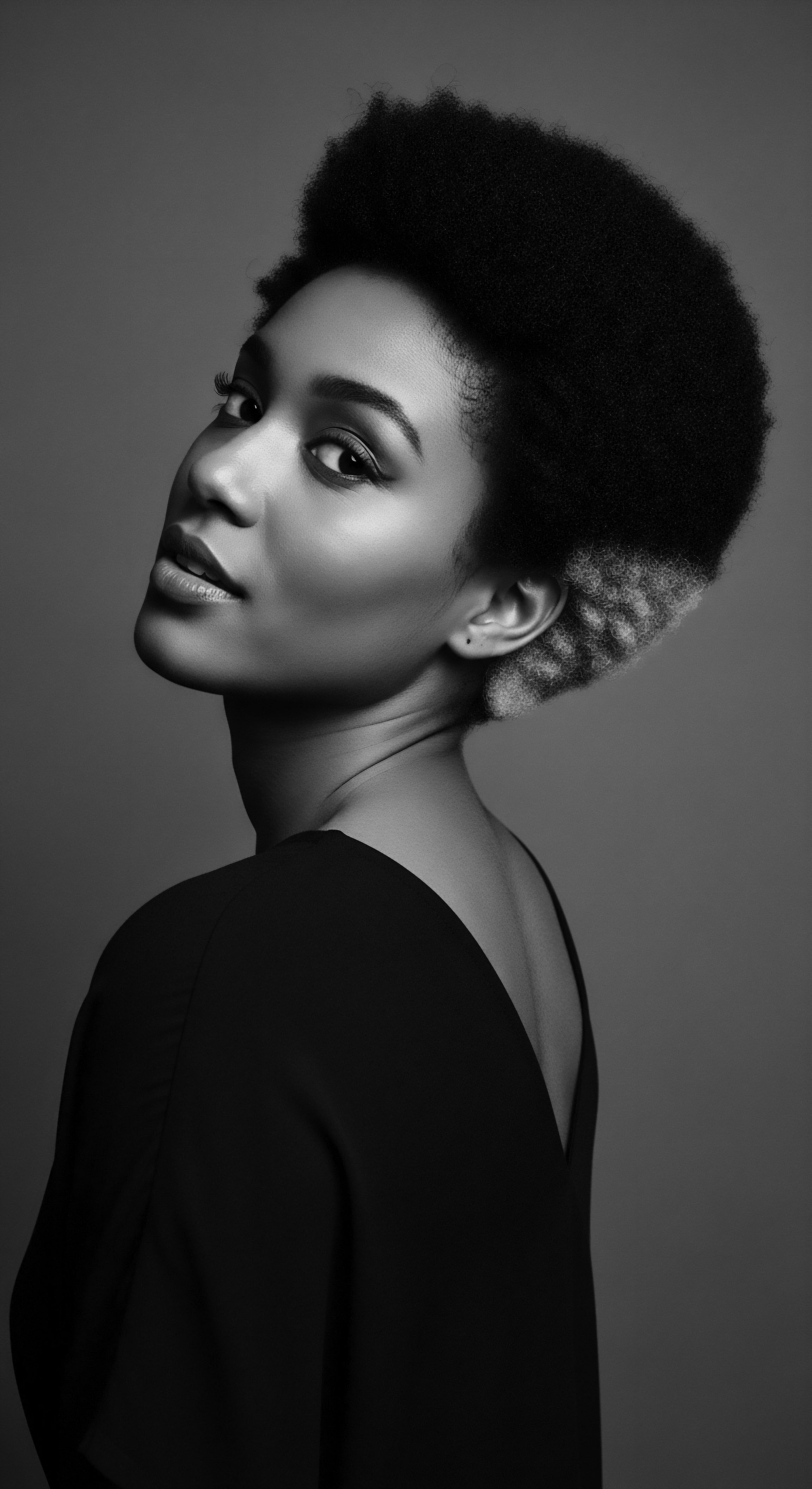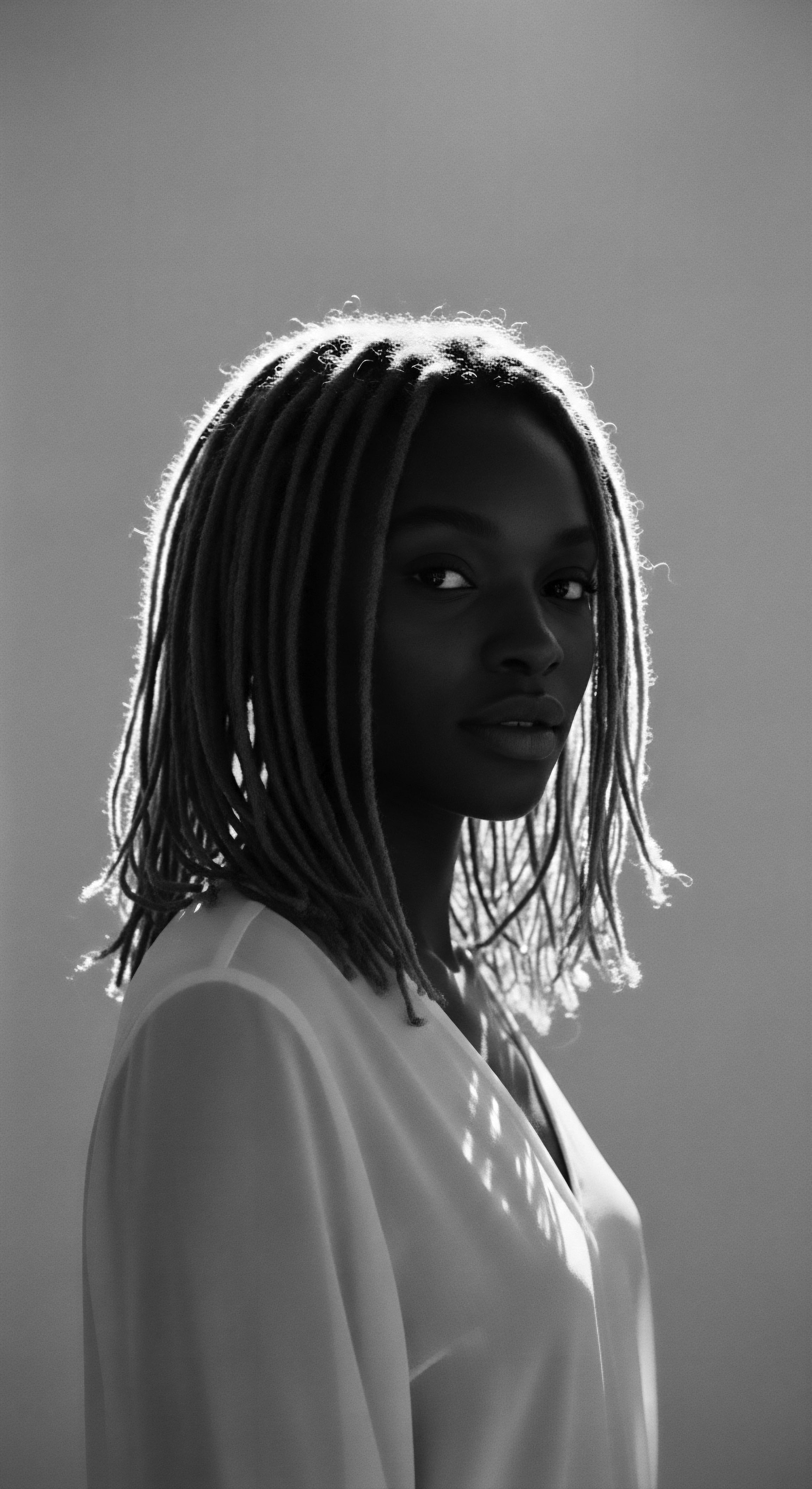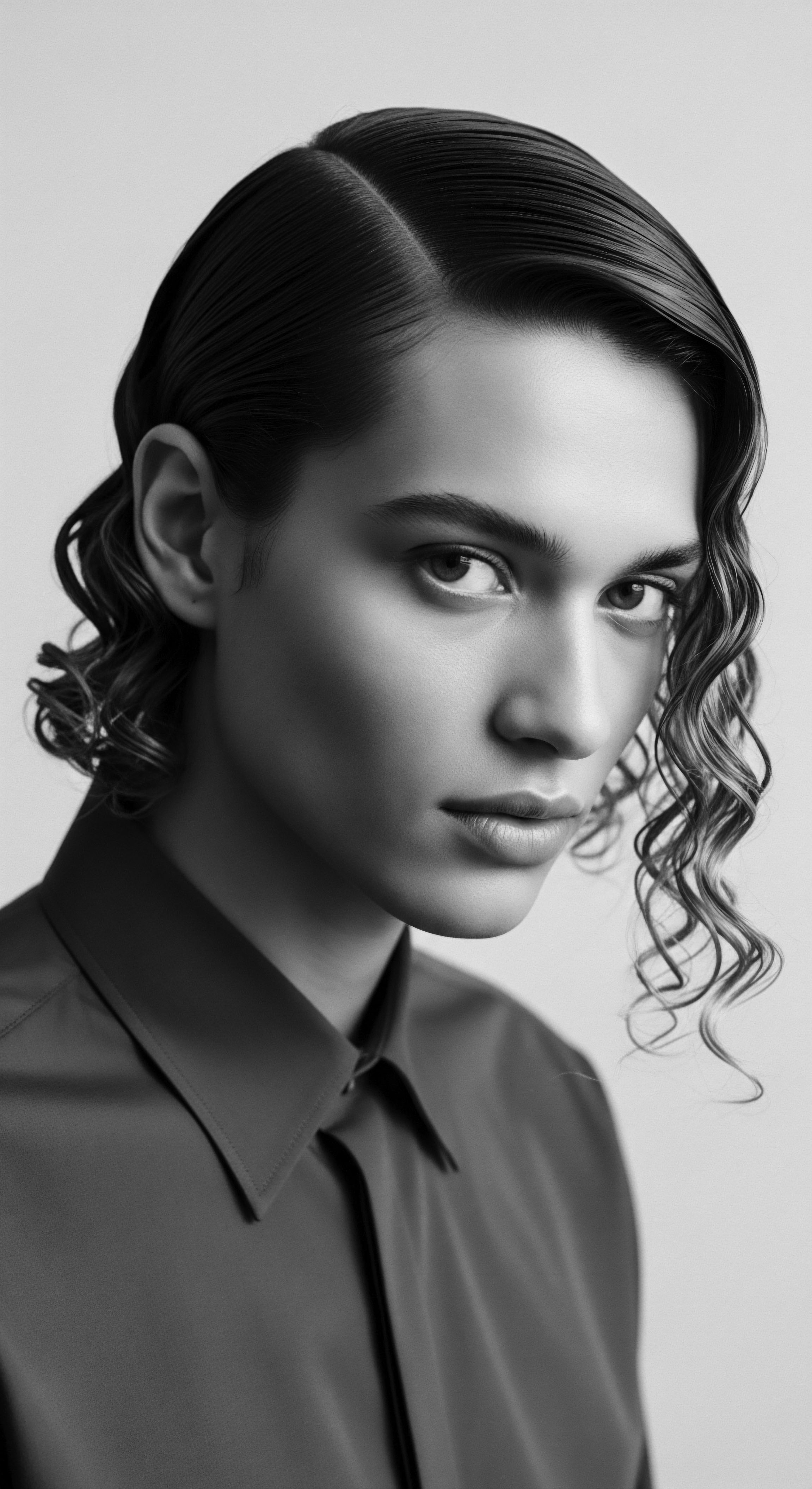
Fundamentals
The Hair Bonnet, at its fundamental understanding, serves as a protective covering for the hair, typically worn during periods of rest or inactivity, most notably overnight. Its primary function centers upon creating a secure, enclosed environment that shields hair from environmental stressors and mechanical friction. This simple yet profoundly effective garment acts as a gentle buffer between delicate hair strands and abrasive surfaces, particularly bed linens, which often consist of materials like cotton.
Such common fabrics possess fibers that, under microscopic examination, reveal a coarse, absorbent structure. These textures, while seemingly benign, can draw essential moisture from the hair shaft and snag individual strands, leading to breakage, frizz, and the disruption of carefully maintained hairstyles.
The inherent design of the Hair Bonnet—a soft, often circular or cylindrical cap typically secured with an elastic band or adjustable ties—facilitates the preservation of hair’s natural moisture balance. Unlike uncovered hair exposed to dry air or absorbent pillowcases, a bonnet establishes a microclimate, keeping natural oils and applied conditioning treatments within the hair’s immediate vicinity. This protective action is especially vital for hair types that are prone to dryness, a characteristic often observed in textured hair. Maintaining optimal hydration levels is a cornerstone of hair health, supporting elasticity and minimizing the risk of damage.

The Physical Shield ❉ Guarding Against Abrasion and Aridity
Within the mechanics of hair care, the Hair Bonnet acts as a direct physical barrier. When one moves during slumber, unprotected hair rubs against pillowcases, causing a constant, low-level friction. This sustained rubbing can lead to the lifting of the hair cuticle, the outermost protective layer of the hair shaft.
Once compromised, the cuticle leaves the inner cortex vulnerable to moisture loss and structural degradation. By enclosing the hair, the bonnet mitigates this abrasive contact, allowing the cuticle to remain smooth and intact, thereby reinforcing the hair’s natural defenses.
Consider the simple act of sleep. Hours spent tossing and turning can equate to significant cumulative friction. The Hair Bonnet minimizes this daily wear and tear, playing a role in maintaining hair’s structural integrity over time. This foundational protective role extends beyond nocturnal use; it is equally valuable during moments of household chores or other activities where hair might encounter snags, dust, or environmental pollutants.
The Hair Bonnet, fundamentally, acts as a vigilant guardian, forming a gentle sanctuary for hair against the world’s common abrasions and the insidious theft of moisture.

Whispers of Ancient Care ❉ A Universal Principle
The underlying principle embodied by the Hair Bonnet—that of protecting hair from damage and preserving its condition through covering—is not a modern invention. Echoes of this wisdom reverberate through ancient practices across various cultures. From elaborate head wraps worn in antiquity for both adornment and protection from elements to more utilitarian coverings for labor, the concept of enclosing hair to safeguard it has been a consistent thread in human history.
While the specific form of the modern bonnet may have evolved, its essential purpose is deeply rooted in this timeless understanding of care and preservation. The early recognition that hair, especially long or intricately styled hair, benefited from a protective sheath speaks to an ancestral intuition regarding longevity and health.
Even in its simplest form, the Hair Bonnet represents a tangible connection to generations that understood the delicate nature of hair and the importance of its preservation. The materials and methods may have transformed, yet the enduring wisdom of enclosing hair for its welfare remains a constant. This basic understanding provides a foundational interpretation of what a Hair Bonnet means ❉ a tool for care rooted in a universal, ancient practice of safeguarding one’s strands.

Intermediate
Moving beyond its elementary protective role, the Hair Bonnet holds a richer meaning, particularly within the context of textured hair care and its complex heritage. It signifies a crucial element in a sophisticated regimen designed to optimize hair health, maintain intricate styles, and prevent common concerns such as dryness, breakage, and frizz. Its utility is not merely about physical shielding; it represents a strategic intervention in the daily and nightly care ritual, reflecting a deeper understanding of hair biology and the specific needs of curls, coils, and waves.
The Hair Bonnet’s intermediate significance lies in its capacity to create an optimal environment for hair to flourish. For many with textured hair, maintaining moisture is a constant challenge due to the hair strand’s natural structure, which often features an open cuticle that allows for rapid moisture evaporation. A quality bonnet, particularly one made from silk or satin, actively combats this tendency, sealing in hydration and allowing conditioners, oils, and styling creams to perform their intended function without quickly dissipating into the surrounding atmosphere or being absorbed by harsher fabrics.

The Material Distinction ❉ Silk and Satin’s Legacy in Hair Preservation
The choice of material for a Hair Bonnet marks a significant distinction in its efficacy. While cotton, as discussed, can absorb moisture and create friction, Silk and Satin possess properties that are uniquely beneficial for hair. Silk, a natural protein fiber, boasts a smooth, tightly woven surface that minimizes friction.
Its low absorbency means it does not strip hair of its natural oils or applied products. Satin, while often a synthetic weave, mimics silk’s smooth surface, offering similar benefits at a more accessible price point.
The application of these smoother fabrics in bonnets transforms them from simple coverings into sophisticated hair tools. This deliberate choice of material points to a deeper understanding of hair science—even if that understanding was historically gained through observation and inherited knowledge rather than laboratory analysis. The ancestral practice of protecting hair, perhaps initially with leaves or finely woven natural fibers, evolved to embrace materials that offered superior glide and moisture retention as they became available through trade and innovation.
The Hair Bonnet’s choice of silk or satin elevates it from a mere covering to a strategic tool for moisture retention and frizz reduction, embodying an astute understanding of hair’s delicate nature.
- Minimized Friction ❉ The smooth surface of silk or satin allows hair to glide rather than snag, thereby reducing cuticle damage and breakage, particularly at the ends and crown.
- Moisture Retention ❉ These fabrics are non-absorbent, meaning they allow hair to retain its natural oils and applied hydration, preventing dryness and brittleness often associated with textured hair.
- Style Preservation ❉ By encasing hair in a non-abrasive environment, bonnets help maintain the integrity of braids, twists, roller sets, and other protective styles, extending their lifespan and appearance.

Preserving the Pattern ❉ Supporting Coils, Curls, and Waves
For individuals with textured hair, the Hair Bonnet holds particular significance in maintaining curl definition and pattern integrity. Coils, curls, and waves are inherently more prone to tangling and frizz compared to straighter hair types, due to their unique structural formation. The bonnet acts as a gentle cocoon, preventing these patterns from being disrupted by friction or humidity fluctuations throughout the night. This preservation of style means less manipulation is needed in the morning, which in turn leads to less mechanical stress and breakage over time.
This intermediate understanding of the Hair Bonnet recognizes it not just as a piece of fabric, but as an integral part of a hair care routine that respects the inherent structure and needs of textured hair. Its utility extends beyond preventing immediate damage; it supports the long-term health and aesthetic coherence of diverse hair textures.

Academic
The Hair Bonnet, when subjected to rigorous academic inquiry, transcends a mere functional accessory, revealing itself as a deeply resonant cultural artifact, a quiet emblem of resilience, and a testament to ancestral wisdom woven into the very fabric of Black and mixed-race hair experiences. Its academic meaning, or its true significance, lies in its interconnectedness with historical narratives, sociological expressions of identity, and the scientific imperatives governing textured hair biology. It is not merely a tool for protection; it represents a continuous dialogue between the past and present, a silent keeper of knowledge passed through generations, and a deliberate affirmation of self in the face of societal pressures.
This comprehensive understanding of the Hair Bonnet demands an exploration of its evolution, from elemental practices of hair preservation rooted in antiquity to its modern-day role as a symbol of cultural pride and self-care. It encapsulates centuries of accumulated knowledge about hair physiology, environmental protection, and the profound psychological impact of maintaining one’s appearance, particularly for communities whose very strands have been politicized and scrutinized.

A Cultural Artifact Defined ❉ The Hair Bonnet as a Repository of Heritage
Academically, the Hair Bonnet serves as a tangible link in the unbroken chain of hair care traditions that span continents and centuries. Its material presence—whether of silk, satin, or more utilitarian fabrics—belies a profound socio-historical significance. It represents a living archive of preventative care, a practical solution born from necessity, and a quiet act of defiance against dominant beauty standards.
The bonnet’s definition expands beyond its immediate physical function to encompass its role in the preservation of heritage, the quiet assertion of identity, and the maintenance of holistic well-being for textured hair. This interpretation underscores its multifaceted nature, existing at the intersection of material culture, historical trauma, and contemporary self-affirmation.

Antecedents in Ancestral Head Adornment ❉ Echoes from the Source
To truly grasp the academic meaning of the Hair Bonnet, one must journey back to its conceptual antecedents within ancient African societies. Before the transatlantic slave trade violently disrupted communities and cultural practices, head coverings held profound significance across diverse ethnic groups, including the Yoruba, Asante, and Maasai. These coverings were seldom purely ornamental; they were integral to the preservation of intricate hairstyles that often conveyed social status, marital status, age, and spiritual beliefs. For instance, among the Yoruba People of West Africa, elaborate coiffures, often woven with extensions or adorned with cowrie shells, could take days to construct for ceremonies or important life events.
Preserving these delicate and symbolic styles was not merely an aesthetic choice; it was an act of reverence for the artistry, the community, and the spiritual significance embedded within the hair. This preservation frequently involved wrapping the hair in soft cloths or carefully tied headwraps overnight or during specific activities.
These ancestral practices, though predating the term “bonnet,” embody the fundamental principle of protecting and preserving intricate hair patterns and health. Anthropological studies highlight how such coverings safeguarded hair from dust, insects, and environmental wear, thereby extending the life of culturally significant styles. This demonstrates an empirical understanding of hair care, where direct observation led to practices that science later validated. Dr.
Afi Ofori-Ansa (2015), in her examination of West African hair culture, notes how various forms of headwear served not only as markers of identity and social standing but also as practical instruments for maintaining hair health and extending the longevity of meticulously crafted hairstyles. This historical precedent underscores that the care and preservation offered by the Hair Bonnet were not novel concepts but rather an adaptation of age-old wisdom, carried forward and transformed by new circumstances.

The Bonnet’s Silent Testimony Through History ❉ The Tender Thread
The Hair Bonnet’s meaning deepens considerably through its painful yet resilient journey across the Middle Passage and into the diaspora. During slavery, the mandated head-wraps often stripped enslaved Black women of their previous cultural expressions, forcing a utilitarian covering that symbolized oppression. Yet, even within this brutal context, the ingenuity and spirit of survival manifested.
These coverings, while imposed, became clandestine spaces where hair could be secretly nurtured, where seeds might be hidden, and where a semblance of personal dignity could be maintained. As communities formed and adapted, the utilitarian headwrap evolved into a more deliberate form of hair protection—the progenitor of the modern bonnet—which served a vital role in preserving hair health in harsh conditions and safeguarding styles that were often created with limited resources and time.
The shift from heavier, more restrictive fabrics to lighter, smoother materials like silk and satin was gradual, often linked to economic shifts and access to different textiles. These materials offered superior benefits for hair and became a quiet luxury, a means for Black women to care for their natural textures without damage. The bonnet became a private emblem of self-care, a tool for preserving a hair identity that was often demonized or deemed “unprofessional” in wider society. Its use enabled Black women to maintain styles that honored their heritage, even if concealed during the day, becoming a foundation for healthy hair growth and length retention that would otherwise be severely challenged by friction and environmental exposure.
| Historical Period/Context Pre-Colonial Africa (e.g. Yoruba, Asante) |
| Hair Covering Principle/Practice Intricate ceremonial hairstyles protected by wraps for longevity and symbolic preservation. |
| Connection to Modern Hair Bonnet Emphasizes ancestral understanding of hair preservation; covering for style retention and sacredness. |
| Historical Period/Context Slavery/Post-Emancipation |
| Hair Covering Principle/Practice Utilitarian head-wraps, sometimes enforced, later used for protective hair care in harsh conditions. |
| Connection to Modern Hair Bonnet Highlights the bonnet's role in survival, secret self-care, and maintaining dignity in adversity. |
| Historical Period/Context Early 20th Century (Great Migration) |
| Hair Covering Principle/Practice Emergence of specific hair nets/caps for preserving straightened or roller-set styles. |
| Connection to Modern Hair Bonnet Points to the bonnet's adaptation for new styles and materials, addressing evolving hair needs. |
| Historical Period/Context Late 20th – 21st Century |
| Hair Covering Principle/Practice Modern silk/satin bonnets; widespread adoption for natural hair care, cultural affirmation. |
| Connection to Modern Hair Bonnet Direct lineage to modern usage, emphasizing health, identity, and entrepreneurial spirit. |
| Historical Period/Context This table illustrates the continuous journey of protective hair coverings, demonstrating how the fundamental desire to protect hair evolved into the contemporary Hair Bonnet, always connected to the heritage of textured hair. |

Contemporary Manifestations of Identity ❉ The Unbound Helix
In the contemporary landscape, the Hair Bonnet’s academic meaning expands to encompass its role as a powerful symbol of identity, self-acceptance, and cultural reclamation. Its widespread adoption, particularly within the Natural Hair Movement, signifies a deliberate rejection of Eurocentric beauty standards that historically coerced Black and mixed-race individuals into altering their natural hair textures. The bonnet allows for the preservation of natural curls, coils, and waves without the need for excessive heat or chemical processing, thereby promoting hair health and affirming one’s innate beauty.
Its presence in public spaces, once confined to the private domain, has also become a subject of socio-cultural discourse. While some debate its appropriateness in certain settings, its visibility champions a broader acceptance of Black women’s natural states and their practices of care. The bonnet, in this light, is not merely a nightcap; it is a visible declaration of self-ownership and a quiet revolution against historical pressures to conform.
It embodies a liberation from the “tyranny of the straight press” and a celebration of authentic texture. This modern interpretation underscores the bonnet’s enduring capacity to voice identity and shape futures, reflecting a continuity of ancestral wisdom in a contemporary context.
In the modern context, the Hair Bonnet stands as a defiant yet gentle emblem of self-acceptance and cultural reclamation, affirming the beauty of natural textures.

Psychological Imperatives ❉ Hair Health and Cultural Affirmation
From a psychological perspective, the consistent use of a Hair Bonnet contributes significantly to mental well-being and self-esteem within Black and mixed-race communities. The meticulous care of textured hair can be a time-consuming and often emotional process, deeply tied to personal identity and cultural heritage. When hair is consistently dry, brittle, or prone to breakage, it can lead to frustration, feelings of inadequacy, and a sense of disconnection from one’s desired appearance.
The Hair Bonnet, by offering a reliable method of preserving hair health and style, reduces these negative outcomes. It minimizes the need for frequent styling, which can be both physically taxing and emotionally draining, particularly for individuals navigating societal expectations regarding their hair.
Furthermore, the act of using a Hair Bonnet, often shared and discussed within community spaces (both online and offline), fosters a sense of collective care and shared understanding. It validates the experiences of those who have historically struggled to maintain their hair in environments that did not support its unique needs. The very existence of this seemingly simple accessory, passed down through generations, reinforces a narrative of resilience, self-sufficiency, and enduring beauty. Studies on the psychosocial impact of hair care within Black communities (e.g.
Brooks, 2018) often point to hair as a significant aspect of self-definition and cultural pride. The bonnet, by safeguarding hair health, directly contributes to this positive self-perception, allowing individuals to step into the world with greater confidence, knowing their heritage-rich strands are protected and cherished. It is a tangible representation of an investment in self, reflecting a deep respect for the ancestral legacy of hair.
- Preservation of Moisture ❉ The enclosed environment created by the bonnet minimizes moisture evaporation, keeping hair hydrated and preventing brittleness, which is a common challenge for textured hair due to its unique porous structure.
- Reduction of Mechanical Stress ❉ By preventing direct contact with abrasive surfaces like pillowcases, the bonnet significantly reduces friction-induced breakage and split ends, particularly for delicate hair strands prone to tangling.
- Maintenance of Style Longevity ❉ The bonnet helps to preserve the integrity of various hairstyles, from braids and twists to wash-and-gos, extending their wear time and reducing the need for daily restyling and manipulation, thus minimizing further damage.
- Support for Scalp Health ❉ By creating a consistent microclimate and preventing external irritants, the bonnet can indirectly support scalp health, which is foundational for strong hair growth and overall hair vitality.

Reflection on the Heritage of Hair Bonnet
The journey of the Hair Bonnet, from its most elemental protective function to its complex identity as a cultural touchstone, illuminates a profound truth ❉ the care of textured hair is inextricably linked to a rich, enduring heritage. This simple garment, seemingly mundane, carries within its soft folds centuries of ancestral wisdom, resilience, and self-affirmation. It echoes the intuitive understanding of those who, generations ago, sought to protect their elaborate coiffures from the elements, ensuring the longevity of styles that held deep cultural and spiritual meaning. The bonnet represents a continuous thread, connecting past practices to contemporary routines, reminding us that every act of care, every moment of protection, is an homage to those who came before.
In its enduring presence, the Hair Bonnet stands as a silent chronicler of transformations—from a utilitarian covering enforced by oppressive systems to a chosen garment symbolizing liberation and self-love. It reflects the ingenuity of communities who, despite immense challenges, found ways to preserve their beauty, their identity, and their hair’s health. It is a testament to the power of small, consistent acts of self-nurturing that cumulatively build a legacy of wellness and cultural pride.
As we consider the future of hair care, the bonnet reminds us that the most innovative solutions often stem from deep historical roots, offering not just physical protection but also a deep sense of belonging and continuity. It allows the unbound helix of textured hair to flourish, a vibrant expression of an unbroken lineage of care and cultural brilliance.

References
- Brooks, R. (2018). Hair Story ❉ Untangling the Roots of Black Hair in America. St. Martin’s Press.
- Opoku, N. (2015). African Traditional Hair Styling ❉ An Historical Perspective. University of Ghana Press.
- Byrd, A. L. & Tharps, L. D. (2001). Hair Story ❉ Untangling the Roots of Black Hair in America. St. Martin’s Press.
- Hooks, B. (1995). Art, Bell Hooks ❉ Black Looks ❉ Race and Representation. South End Press.
- Wilkerson, I. (2010). The Warmth of Other Suns ❉ The Epic Story of America’s Great Migration. Random House.
